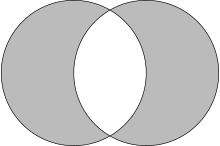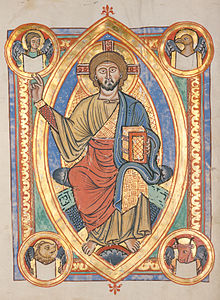Vesica piscis

The vesica piscis is a shape which is the intersection of two circles with the same radius, intersecting in such a way that the center of each circle lies on the circumference of the other. The name literally means the bladder of the fish in Latin. The shape is also called mandorla ("almond" in Italian).
The term is also used more generally for any symmetric lens.[1]
Mystical and religious significance

It has been the subject of mystical speculation at several periods of history, perhaps first among the Pythagoreans. The mathematical ratio of its width (measured to the endpoints of the "body", not including the "tail") to its height was reportedly believed by them to be 265:153 (namely 1.73203...). The geometric ratio of these dimensions is actually the square root of 3, or 1.73205... (since if straight lines are drawn connecting the centers of the two circles with each other, with the two points where the circles intersect, two equilateral triangles join along an edge). The ratio 265:153 is an approximation to the square root of 3, with the property that no better approximation can be obtained with smaller whole numbers. The number 153 appears in the Gospel of John (21:11) as the number of fish Jesus caused to be caught in a miraculous catch of fish. Coventry Patmore has written a poem called Vesica Pisces, Part XXIV of the Book I of his cycle The Unknown Eros (1877). [2] [3] [4] [5] [6]
More recently, numerous new age authors have interpreted it as a yonic symbol and claimed that this, a reference to the female genitals, is a traditional interpretation. [7] [8] [9] [10] [11]

Uses of the shape
In Christian art, some aureolas are in the shape of a vertically oriented vesica piscis, and the seals of ecclesiastical organizations can be enclosed within a vertically oriented vesica piscis (instead of the more usual circular enclosure).
The cover of the Chalice Well in Glastonbury, Somerset depicts a stylized version of the vesica piscis design.
References
- ^ Weisstein, Eric W. "Lens". MathWorld.
- ^ Archimedes of Syracuse: On the Measurement of the Circle.
- ^ Rachel Fletcher: Musings on the Vesica Pisces. Nexus Network Journal (ISSN 1590-5869), vol. 6 no. 2 (Autumn 2004)[1]
- ^ John Michell: City of Revelation. Abacus, 1972. (ISBN 0-349-12320-9)
- ^ John Michell: The Dimensions of Paradise: The Proportions and Symbolic Numbers of Ancient Cosmology. Adventures Unlimited Press, Kempton, Illinois, 2001.
- ^ David Fideler: Jesus Christ, Sun of God: Ancient Cosmology and Early Christian Symbolism. Quest Books, Wheaton, Illinois, 1993.
- ^ Barbara Walker, The Woman's Encyclopedia of Myths and Secrets (Harper San Francisco, 1983)
- ^ Kevin L. Gest, The Secrets of Solomon's Temple (ISBN 0853182566)
- ^ Kathy Jones, The Goddess in Glastonbury (1990)
- ^ Margaret Starbird, Magdalene's Lost Legacy, Symbolic Numbers & Sacred Union
- ^ Constance S. Rodriguez PhD, LCSW - Sacred Portals, Pathways to the Self (ISBN 9781403375926)
